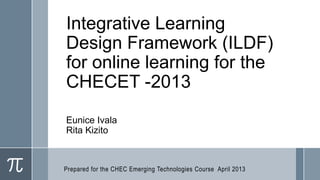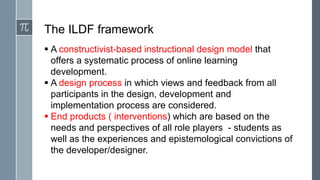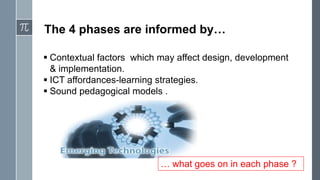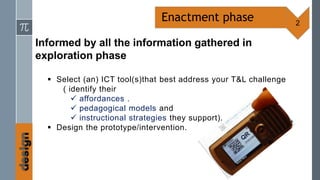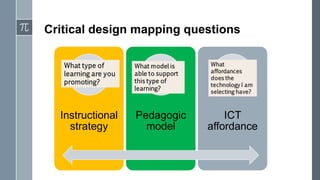Integrative learning design framework (ildf) for the checet 2013 course
- 1. Integrative Learning Design Framework (ILDF) for online learning for the CHECET -2013 Eunice Ivala Rita Kizito Prepared for the CHEC Emerging Technologies Course April 2013
- 2. Integrative Learning Design Framework (ILDF) for online learning 1. Exploration Instructional 4. Reflection Designer 2. Enactment 3. Evaluation Adapted from Dabbagh and Bannan-Ritland (2005)
- 3. The ILDF framework  A constructivist-based instructional design model that offers a systematic process of online learning development.  A design process in which views and feedback from all participants in the design, development and implementation process are considered.  End products ( interventions) which are based on the needs and perspectives of all role players - students as well as the experiences and epistemological convictions of the developer/designer.
- 5. The 4 phases are informed by…  Contextual factors which may affect design, development & implementation.  ICT affordances-learning strategies.  Sound pedagogical models . … what goes on in each phase ?
- 6. Exploration phase 1 Investigate the context within which the online learning activity will be designed and implemented › Teacher and learner needs. › Teaching and learning challenges. › Theory and instructional strategies used to (identify problems/gaps/opportunities). › Social, cultural and organisational factors that may constraint design, development and implementation. › Designer beliefs, attitudes, biases, experience, assumptions, educational philosophy. › Literature review on ICTs available, their affordances and the pedagogical models and instructional strategies they support.
- 7. Enactment phase 2 Informed by all the information gathered in exploration phase  Select (an) ICT tool(s)that best address your T&L challenge ( identify their  affordances .  pedagogical models and  instructional strategies they support).  Design the prototype/intervention.
- 8. Overlapping Instructional strategy clusters Diverge towards promoting self-directed learning Dialogical Exploratory Supportive Converge towards promoting authentic learning
- 9. Critical design mapping questions Instructional Pedagogic ICT strategy model affordance
- 10. Evaluation phase 3 Assess if the designed prototype/ intervention is user friendly, valid & relevant to address the T&L challenge and instructional outcomes it is intended for  Formative-done in the development stages of the prototype to judge the strengths and weaknesses of the prototype-results are used to revise/refine the prototype /instruction to improve its effectiveness and appeal -expert reviews -one-on-one with colleagues -small group of students  Summative – done after the implementation of the prototype to measure the impact of the prototype on teaching and learning
- 11. Reflection phase 4 Critically think of the experiences you went through in the whole process of designing the prototype  The design model  Lessons learnt  Possible applications of the prototype Lessons learnt in the whole process could be used to redesign the intervention or other new interventions

